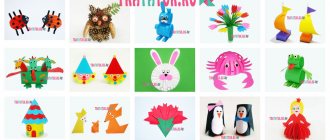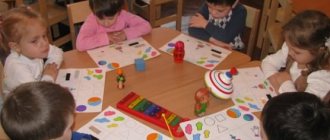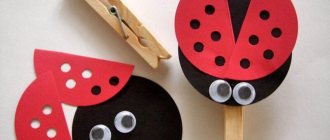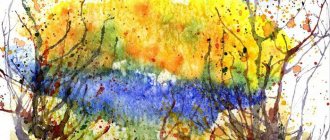The question “How to teach children to draw a person?” It baffles many adults: not everyone can realistically convey proportions and portrait likeness, much less explain the stages of drawing a human figure to a child. We will show simple diagrams and give recommendations on how to draw a person step by step - even an adult child can do it.
shkolabuduschego.ru
Most adults, not engaged in professional artistic activities, stopped in their development at the “cephalopod” stage. But this is not a reason to turn away a child with a pencil who wants to explore this world and learn everything.
By drawing, the child fantasizes, develops his abilities, and trains visual memory. Of course, drawing a person is much more difficult than a tree or a hedgehog, but even the most complex task can be broken down into simple steps so that it does not seem so scary and impossible. Let's learn together!
The benefits of step-by-step drawing
Parents should understand that it is much easier to teach a child to portray people using sequential actions than through observations and sketches. In addition, you need to remember the benefits of this method of drawing:
- developing the ability to follow clear instructions;
- the ability to separate an entire object into individual parts;
- the ability to bring your own vision into the picture;
- manifestation of independence.
Required Tools
Before creating your first painting, you need to make sure you have the necessary equipment:
- a workplace with good lighting;
- a simple pencil, you can immediately purchase both a soft and hard version, for a small child - preferably with edges;
- paper - individual sheets or album;
- eraser;
- sharpener;
- colour pencils.
Age characteristics
You can start drawing people step by step until you are four years old. The main thing is that the baby can already hold a pencil and be familiar with the existence of simple geometric shapes. What are the features of drawing at different ages:
- up to 3 years old, a child will be able to draw a basic man if he uses a prepared template;
- from 3 to 4 years - you can start drawing a person with an image of a snowman or matryoshka doll;
- from 4 to 5 – complicate the picture, add detail to your nesting doll;
- from 5 to 6 – draw a person using simple shapes: ovals, circles, rectangles, lines;
- From 6 years old you can begin to depict people in more detail, draw them in different poses, in motion or at rest.
How to build an image of a person using geometric shapes
The methodology of a lesson on a given topic in kindergarten is based on the similarity of certain parts of the body with geometric shapes. So, babies’ heads are round, adults’ heads are oval, legs and arms look like rectangles, etc.
You can make a silhouette of a person from any shapes - circles, rectangles, squares.
To solve this problem, the preschooler is given blanks made of paper or cardboard, and he draws up a layout according to a given scheme or comes up with his own sketch. A more difficult task is to draw a person yourself using geometric shapes.
Simple algorithm
If you are wondering how to teach a 5-year-old child to draw a person, especially if he has no previous experience in such drawings, then you should start with a simple plan of action. Moreover, it will be correct if you first show how to portray a person, and then, if necessary, guide the baby’s hand, helping to repeat the sequence of actions and the correctness of the lines.
- Draw an oval that will become the head.
- Below it we draw a large rectangle, but at a small distance from the oval. This will be the torso.
- We connect the rectangle and the oval using two straight lines - this is the neck.
- Add four rectangles to create arms and legs.
- On the hands we draw the fingers in the form of small rectangles.
- On the legs we draw some kind of boots.
- On the head (on the sides) we add two circles - these are the ears. We add curls inside them.
- We draw facial features. We do this in the most basic way. The eyes are small circles, the nose is a vertical line, the lips are a concave arc.
- Adding clothing items.
- You can start coloring.
I’ll tell you about myself: I’ve never been able to draw people, or maybe I just didn’t want to learn it. Animals, nature, still lifes - that's it, please. My son also has not yet shown interest in this kind of drawings. He loves to depict various types of transport, buildings and nature.
Progress of the lesson.
(the guys are sitting at the table on their chairs)
- Guys, what holiday is coming soon? (February 23)
-On this day, you and I will congratulate our dads, grandfathers, brothers and our boys, future Soldiers.
- What can you give? And what wishes can you wish for?
(Children suggest what to give; one option is to draw a postcard with warriors .)
Before you start drawing, you need to do finger exercises.
There are five fingers on my hand
Five grabbers, five holders.
To plan and to saw,
To take and to give.
It's not hard to count them:
One two three four five!
The teacher shows the sequence of drawing a man in military uniform .
Children draw a portrait on a postcard. The teacher pays attention to technical skills, if necessary, attracts children to the flannelgraph - to clarify the location of individual parts
2. Then we draw the body, arms, legs.
3. Then we draw the hands, cap, boots.
(rotation in front of the chest with arms bent at the elbows)
They sat quietly in the clearing,
(sit down, hands to knees)
And they flew again.
4. Draw in the eyes, eyebrows, nose, and mouth with a simple pencil.
—Which postcard did you like the most?
Tell me again what holiday is coming soon? Dads and grandfathers will be happy with such gifts.
All the work is good, we tried our best!
Summary of an open integrated lesson (drawing, the world around us) in the middle group: “Spring Forest” Purpose: To form in children a desire to get acquainted with, emotionally perceive works of fine art, and notice expressiveness.
Summary of a lesson on fine arts activities in the middle group “Decorative drawing” “Deer - branchy antlers” Decorative drawing Program content: introduce the gingerbread industry of Russia. Learn to decorate a figurine.
Basics of Proportions
How to teach a 7-year-old child to draw a person if he already has good experience behind him? It's time to introduce him to the correct proportions of the human body.
- The head is outlined.
- A vertical line is lowered, which will include seven more ovals of the same size.
- The center of the chest is at a distance of two measured units (ovals below the main one, which is the head).
- Three units will lead to the navel.
- The pubic bone is marked after four units.
- The center of the knees will be indicated by a measured area of five heads and the distance from the top of the head to the future eyes.
- The middle part of the shin is 7 units.
It is also important to consider the following points:
- the width of the head and the female shoulder are equal;
- The shoulder width of men is equal to one measured unit;
- the width of the chest corresponds to three units;
- the elbow of the person depicted should be at the level where the thigh begins;
- the oval, which represents the torso, should be larger than the one that represents the pelvis.
Consultation for educators. Methods of drawing a person in different age groups
Consultation for educators
Methods of drawing a person in different age groups
The image of a person is the most difficult thing in the development of visual creativity of preschool children, which, gradually becoming more complex, occupies a place in children's drawings throughout preschool childhood.
Children whose attention and visual memory are poorly developed are lost. Basically, in the drawings of children, people stand with their arms outstretched helplessly and their legs spread apart. And only talented, gifted children can convey movement.
Everything is natural and very nice for a certain period, but there must be development! I have learned from experience and believe that drawing a person should be introduced into work with children as early as possible. Young children are not yet afraid of making mistakes, they like everything, and drawing a person in children’s drawings occupies one of the most preferred places in their visual activity. But the quantity and quality of images of people directly depends on how a child (especially of older preschool age) can do it.
In order for a child to be able to convey his plans in a drawing, he must have visual and technical skills. Often, a child, dissatisfied that his image is not done at the proper level, may simply refuse to draw human figures. Experience shows that due to difficulties in depicting a person, children try to avoid depicting the image of a person in independent creative activities. Based on this, it is necessary to teach children how to draw a person, showing a variety of ways to depict them. And for the teacher, the primary task should be to teach children to depict a person in accordance with his age and individual abilities
Children begin to try their hand at drawing the human figure shortly after three years of age. At this time, they use several basic strokes with which they can portray a person: mom, dad or another family member. The child draws the figure according to the same pattern: “Stick, stick, cucumber, here comes the little man!” The conclusion suggests itself: for there to be development, systematic, planned training is necessary.
Teaching preschool children to depict a person is a complex and painstaking process, requiring the teacher to be able to take into account a number of requirements in his work and create the necessary conditions for children's creativity. Pedagogical guidance should be aimed not only at teaching the art of depicting a portrait, but also at developing perception and imagination. In other words, it is necessary to teach children to see and perceive, to gradually bring them to the understanding that their image can express different contents and the management of the process should be aimed, first of all, at the development of aesthetic perception, at the figurative reflection of their impressions in the drawing using certain visual means. It is necessary to find pedagogical techniques that can arouse interest in drawing a person, emotions, and the imagination of children, intensify the drawing process, evoke a desire to evaluate the drawing, and find elements of expressiveness in it.
A child in the world around him does not catch everything that his eyes see, therefore, in classes on developing the ability to portray a person, it is necessary to teach children observation skills in order to more fully and truthfully convey the characteristic features and traits of the person being depicted.
In the process of educational work in this direction, children develop an understanding of the created image, the beauty and expressiveness of a portrait drawing.
In addition to all that has been said, a free and creatively created image by a child of the world of people will not only allow him to experience the joy of creativity, the joy of creating expressive images, but also, finally, will help him more easily enter into real relationships with the surrounding world of people, that is, it will provide one of the ways to carry out the process socialization of a preschool child. Drawings by older preschoolers show their interest in both social problems and the life history of their people.
It is also important that children of senior preschool age will soon go to school, and practice shows that a first-grader who does not know how to portray a person will find it quite difficult to create “lively”, bright works for which the teacher will give a positive mark, which in turn is the main motive for a child - a first grader.
Middle group.
In the middle group, children learn to draw a “matryoshka doll”. The head is depicted, with an extended sundress towards the bottom. “Snow Maiden” - head, widened fur coat towards the bottom, arms from the shoulder. By the end of the year, the image becomes more complex, you can add the “raised hand” movement.
In the older group, children are encouraged to draw in more detail. You can suggest a drawing scheme from geometric shapes, a head drawing scheme.
Invite children to look at a doll or child in beautiful clothes. Clarify by asking children the shape of the dress, head, arms, legs, their location and size. Facial proportions: the head is oval in shape. To depict the face, the head is divided by transverse lines into three parts: from the top to the brow ridges, from the brow ridges to the tip of the nose, and from the end of the nose to the end of the chin. The teacher draws an oval of the face on the board, notes auxiliary lines, explaining that they ate noticeable ones, shows how eyes are drawn, the distance between the eyes is small, no more than one eye, inside the eye there is a colored circle and a small pupil. Asks what is above the eyes (eyebrows). He further explains that a person’s nose is the same color as their face, so you only need to draw the tip of the nose. You can draw the tip of the nose with a short line or depict nostrils. From the tip of the nose to the end of the face, the lips are in the middle.
- Children, look at each other. Do you see that the upper lip is different in shape from the lower? There are, as it were, two waves on the upper lip, and one on the lower lip (draw lips). We draw ears and hair.
In the preparatory group we introduce children to the human structure. Consider the structure of the human figure and the proportional relationship of parts. The figure shows that when determining proportions, any part of the body, usually the head (its height), is taken as a scale unit. The height of the entire human figure is 7-8 scale units (including the head). The dimensions of the length of the body and head together are approximately equal to the length of the legs. The arms are one unit longer than the body (reach mid-thigh). The arm to the elbow is longer than the forearm; The elbow is at waist level (about halfway across the body). The width of the figure at the shoulders is approximately two units. The legs at the knees are divided into two equal parts.
Let's consider one of the ways to draw a person in motion. Theme: “Ski trip”. One of the drawing methods is drawing with ovals. We draw an oval - the torso to the waist, the oval-pelvic part. Then we will draw ovals - legs to the knee, from the knee - ovals, ovals - feet. Then we will draw the arms, first finding the place of the shoulder. We draw the hands in the same way: an oval up to the elbow, an oval after the elbow. The elbow is at waist level, the palm is an oval. And finally - the head. Find a place for the neck and draw the head. Then, using a smooth line, we assemble the pattern and dress it. After you have drawn a pencil sketch, use an eraser to erase the auxiliary lines. Let's start working in color.
In the middle group, children learn to draw a “matryoshka doll”. The head is depicted, with an extended sundress towards the bottom. “Snow Maiden” - head, widened fur coat towards the bottom, arms from the shoulder. By the end of the year, the image becomes more complex, you can add the “raised hand” movement.
In the older group, children are encouraged to draw in more detail. You can suggest a drawing scheme from geometric shapes, a head drawing scheme.
Invite children to look at a doll or child in beautiful clothes. Clarify by asking children the shape of the dress, head, arms, legs, their location and size. Facial proportions: the head is oval in shape. To depict the face, the head is divided by transverse lines into three parts: from the top to the brow ridges, from the brow ridges to the tip of the nose, and from the end of the nose to the end of the chin. The teacher draws an oval of the face on the board, notes auxiliary lines, explaining that they ate noticeable ones, shows how eyes are drawn, the distance between the eyes is small, no more than one eye, inside the eye there is a colored circle and a small pupil. Asks what is above the eyes (eyebrows). He further explains that a person’s nose is the same color as their face, so you only need to draw the tip of the nose. You can draw the tip of the nose with a short line or depict nostrils. From the tip of the nose to the end of the face, the lips are in the middle.
Children begin drawing from the cone-shaped body.
First topic: “Girl in a long fur coat.”
This topic is divided into two lessons.
1 lesson
Gouache – blue and flesh-colored (pink), wide brush.
Explanation:
I take a brush and paint the girl’s head with pink paint – it’s round. Now I will paint the girl’s long fur coat with blue paint. I step back a little from the head and draw a triangle. The fur coat has sleeves, like spruce branches, I paint with one downward movement of the brush. The girl has a hat on her head. To draw eyes, lips, nose, you can give a pencil or felt-tip pen. The teacher himself can draw: “Let’s bring your girl to life.”
Lesson 2
If the children did a good job, then we give them white paint and offer to draw the edge of the fur coat and hat. If it didn’t turn out well enough, you can invite all or some of the children to draw a friend for the girl. “You and I have already drawn a girl in a long fur coat, let’s draw a friend for her so that she won’t be bored.”
Lesson 3 – “Bear”
To make it easier for children to draw a naked doll in the next lesson, we first teach them how to draw a bear.
Gouache – brown, black, 2 brushes: wide and medium thickness.
Explanation:
I take a brush and use brown paint to paint a bear with a round head. To make the bear have an oval body, I will draw 2 circles - one under the other and then connect them, I will get an oval - the body of the bear. I will draw small ears on the head. Now I’ll draw oval paws - 2 at the top and 2 at the bottom (show). When the paint dries, paint the eyes and nose with black paint.
Lesson 4 – “Nude Doll”
Gouache - yellow, red, black. 2 brushes: wide and medium thickness.
Explanation:
We draw it in the same way as a bear, but we immediately draw the body oval. Oval arms and legs. Instead of ears we draw hair. Let's draw panties. When the paint dries, we bring the doll to life - draw eyes, a nose, and a mouth.
Lesson 5 – “Doll in a red dress”
Gouache – yellow, red, black. 2 brushes: wide and medium thickness.
Explanation:
We draw it the same way as a naked doll, but we dress it in a dress (triangle).
Senior and preparatory groups
A simple pencil.
We draw a person according to the diagram.
Explanation:
To make it easier for you to learn how to draw a person, I will teach you first to draw a diagram, and then from it - a little man. A person has a round head - draw a circle. Short neck - draw a vertical line. Now I draw a horizontal line - this is the line of the shoulders, it is wider than the head. Now I’ll draw a longer vertical line - this is the line of the body, it is equal to the size of two heads. Below I will draw the line of the hips, it is equal to the line of the shoulders. On the body I will mark the waist line, it is equal to half the shoulder line. Now I will draw a line of arms obliquely from the shoulders to the line of the hips. From the line of the hips we draw the lines of the legs; they are longer than the torso.
Several lessons are devoted to drawing diagrams until all children have mastered it, since this is the basis of the basics.
"Man on the Move"
A simple pencil.
Explanation:
In the first lesson, we draw the same diagram as usual, but mark the bend points on the arms and legs. Then we show how to draw a diagram to convey movement. To convey movement, you can use a child to show the direction of the lines of the arms and legs.
"Man on the move." Of course, it would not be easy to draw a person in motion if there was only one way of drawing, because we are all so different and our perception of the surrounding reality is also different. Fortunately, there are several ways of drawing and everyone can choose the most suitable one for themselves. Today we will talk about three ways to depict the figure of a moving person.
The first schematic drawing is traditional drawing, where we draw the human body with straight lines and then “dress” it with clothes.
1)2)
The second way is to draw with ovals. With this method, we convey the proportions of the human body using ovals of different sizes.
The third method is drawing with arcs, where we can depict a human figure using arcs, long and short, turned in different directions.
For all methods, without exception, you need a basic understanding of the proportions of the human body, which we will later study on the multimedia slide.
Explanation:
And so, we take the first sheet of paper and outline with a pencil, a barely noticeable line, the size of our person. Then, using lines, we depict the human skeleton, taking into account its proportions and the inclination of the torso, head, as well as the position of the arms and legs. Having drawn a diagram, we “dress” a person in clothes. The schematic representation is traditionally well known to everyone, so it does not cause any difficulties.
To master the method of drawing with ovals, take a blank sheet.
The entire drawing of a person consists of seven ovals the size of his head. That is, the full height of a person will be equal to seven circles, in one of which you will draw the head and neck. With the help of such a scheme, the proportions of the drawing will be strictly observed. The main thing is to draw the ovals the same. Let's try to make a drawing of a standing person and make the markings as on the slide, namely for the head and neck, shoulders and collarbone, chest, abdomen, legs and arms. Apply all these parts of the body to the previously prepared diagram, separately. First, on a drawing of a person, you need to draw an oval for the head, then an oval for the shoulders and circles for the joints. Next, draw two ovals placed on top of each other, the higher oval should be larger than the lower oval, this will be the chest and stomach of the person. Then you need to draw an oval for the hips, and then two ovals attached to the hips, these are the person's knees. The next step is to draw the legs and outlines for the arms as shown in my drawing. Now all that remains is to draw the general shape of the person’s torso and get the outline of a standing person. This is a very simple method, but it is very effective for those who have never drawn a person and helps to maintain exactly his proportions in the drawing. It will not be at all difficult for you to draw the general shape of the human body. Just trace all these ovals and circles with a pencil. The line can be very approximate, because the person in the picture is standing in clothes. Remove all extra contour lines and draw the person's clothes
paper and draw the coordinate axis with very thin lines. Having stepped back equal segments from the horizontal axis up and down, we mark the person’s height with dots (both halves are the same size). Now we divide the lower part into two halves, these are the human knees. We also divide the upper part into two halves; this line separates the chest from the torso.
Method three,
drawing with arcs. Let's take a blank sheet of paper and try to draw, for example, a figure skater. We put a point just above the middle of the sheet (neck), draw two lines down from it, the arcs are wide at first, but gradually narrowing down, the lines are parallel. Then we draw two arcs upward, according to the same principle (hand), see the direction of the lines on the slide. We draw two arcs in the same way parallel to the lower lines, but a little more curved and a little shorter (the second leg in perspective). From the point from which we started the drawing, we outline an oval (head), all that remains is to work out the small details, arms, skates, hair, dress. Middle-aged children can easily cope with this drawing, it is so simple.
So, in practice, we have mastered three types of images of a person in motion; if you wish, you can use all the skills and drawing techniques in one image to improve your drawing skills.
Get text
Drawing of an experienced kid
Older children who understand what human figures are like will be able to draw more detailed pictures with a pencil.
- We schematically draw a future person by making sketches. We depict it with simple geometric shapes.
- We draw the neck, make characteristic curves on it, and decide on the width.
- We depict the line of the shoulders, taking into account whether we are a man or a woman.
- We mark the waist; its width also depends on the gender of our person.
- We draw the arms, mark the elbows and hands.
- Let's start with the legs, draw the presence of the knees, make the hips wider than the shins, draw the feet or boots if our little man is wearing shoes.
- We finish drawing the ears, hair, and do the detailing of the face.
- You can start drawing out the details of the clothing.
- We color our picture, bringing the little man to life.
Read also
Topic of the week: “Parts of the body and face”
Topic of the week: “Parts of the body and face” Lesson 20. Grandmother and grandfather (Applying plasticine to the surface) Program content. Continue teaching children how to apply plasticine to a given surface; bring the product to the desired image using threads and plasticine. Consolidate knowledge
Topic of the week: “My Home”
Theme of the week “My Home” Lesson 22. House for a bunny and a rooster (Plasticine modeling) Program content. Strengthen children's ability to bring a product to the desired image using plasticine. Learn to retell fairy tales based on illustrations. Demonstration material. Heroes
Topic of the week: “Parts of the body and face”
Topic of the week: “Parts of the body and face” Lesson 1. Face of a clown (Modeling from plasticine using additional material) Program content. Teach children to roll balls from plasticine and attach them to a given base. Strengthen children’s ability to navigate
Theme of the week: “Transport”
Topic of the week: “Transport” Lesson 25. The train is rushing (Free choice of material) Program content. Learn to depict objects that resemble different geometric shapes (rectangle, circle, square). Draw complex objects with a simple pencil, conveying the shape of the main ones
Topic of the week: “My Home”
Topic of the week: “My Home” Lesson 41–42. Houses of the Three Little Pigs (part 1–2) (Drawing with pastel crayons, sanguine, charcoal, wax crayons) Program content. Continue learning how to make illustrations for fairy tales. Develop the ability to arrange objects on a sheet of paper. Learn
Theme of the week: “My City”
Theme of the week “My city” Lesson 43. The Kremlin (Drawing with gouache) Program content. Cultivate an interest in the history of your hometown. Learn to outline the silhouettes of the towers and walls of the Kremlin with a simple pencil, conveying their shapes and structure. Continue learning to use different shades
Topic of the week: “Parts of the body and face”
Topic of the week: “Parts of the body and face” Lesson 1. There are such boys (Drawing with a simple pencil) Program content. Teach children to draw a happy and sad face with a simple pencil. Learn to analyze and understand the content of a poem. Cultivate benevolence
Theme of the week: “Furniture”
Topic of the week: “Furniture” Lesson 11. Blanket for Vanyushka (Drawing with felt-tip pens) Program content. Teach children to decorate a rectangular object with colored stripes, alternating them by color. Learn to understand and analyze the content of the nursery rhyme. Cultivate benevolence
Theme of the week: “Clothing”
Topic of the week: “Clothing” Lesson 12. My winter hat (Brush painting. Gouache) Program content. Teach children to draw a hat with a simple pencil; paint over with gouache of different colors. Develop thinking, attention. Material. A large sheet with drawn three hats (red,
Topic of the week: “My Home”
Theme of the week “My Home” Lesson 21. Houses for nesting dolls (Drawing with colored pencils) Program content. Teach children to draw small and large objects consisting of a square and a triangle. Continue learning how to compose a plot composition. Cultivate responsive
Topic of the week: “My Home”
Theme of the week “My Home” Lesson 41. Ice hut (Drawing with pastel crayons) Program content. Continue to introduce children to cool tones. Learn to convey the characteristic features of objects using cool colors. Introduce opportunities
Topic of the week: “Parts of the body and face”
Topic of the week: “Parts of the body and face” Lesson 20. Clown mask (Brush painting. Watercolors) Goal. Teach children to draw a clown’s face with a simple pencil, consisting of circles of different sizes; navigate parts of the body and face. Strengthen the ability to analyze content
Topic of the week: “My Home”
Topic of the week: “My Home” Lesson 22. Fence near the house (Brush painting. Gouache) Purpose. Continue to teach children to draw various objects consisting of combinations of lines. Learn to retell fairy tales based on illustrations in the book. Develop speech and thinking. Demonstration
Topic of the week: “My Home”
Topic of the week: “My Home” Lesson 21. Building a house (Modeling from plasticine) Program content. To develop in children the ability to sculpt a house from rolled up columns, placing them on top of each other and firmly connecting them together. Strengthen the ability to use a stack. Develop
Theme of the week: “My friends”
Theme of the week “My friends” Lesson 28. Cipollino (Modeling from plasticine in combination with natural materials) Program content. Continue to teach children to sculpt the figure of a fairy-tale character using a combined method, conveying the shape of the head, torso, legs, arms and observing
Topic of the week: “My Home”
Theme of the week “My Home” Lesson 22. House for a bunny and a rooster (Colored paper. Application from prepared parts of an object) Program content. Cultivate compassion and kindness. Teach children to form a whole from several parts; apply glue to the part and stick it
Source
Recommendations
Parents should understand that teaching a child to draw a human figure can be a difficult task. In this case, the following points must be observed:
- do not push the child, do not expect quick results;
- do not criticize his first attempts, much less laugh at him;
- diligence and consistency of actions, regular training will bear fruit;
- you must always follow the algorithm of actions, do not change points;
- during your first attempts, you can use a template, then samples, and then move on to drawing on your own;
- Praise your child even for the smallest victories.
Now you know how to teach a child to draw a person. Remember the need for consistent training. Never put pressure on your child, demanding quick and high-quality results from him. Do not force drawing if the child does not like this type of activity at all. Creative impulses must come from the heart and be filled with the emotional experiences of the little one.








